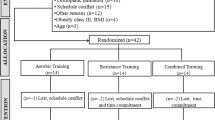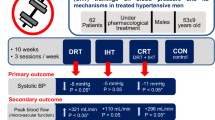Abstract
The effect of short-term aerobic exercise on vascular function of young individuals with a family history of hypertension was investigated. Thirty young men with a family history of hypertension were randomly assigned to either an exercise (n=15) or control (n=15) group. Exercise subjects performed 30 min of supervised cycle training at 65% of their maximal oxygen uptake (V̇O2max), three times per week for 4 weeks. Control subjects were asked to maintain their normal levels of physical activity. Peak leg and forearm blood flow were assessed using plethysmography and was determined as the highest blood flow following 5 min of reactive hyperemia. Cardiopulmonary baroreceptor (CPBR) sensitivity was measured using lower body negative pressure (LBNP) for 5 min at −20 mm Hg. CPBR was determined by calculating change of stroke volume and forearm vascular resistance at baseline and during LBNP. Carotid baroreceptor (CBR) sensitivity was assessed using neck suction at −20, −40, −60 and −80 mm Hg pressures, and was determined from RR interval divided by systolic blood pressure. Augmentation index (AIx), a measure of arterial stiffness, was assessed using applanation tonometry and was calculated as the ratio of augmented pressure and pulse pressure. The major findings were that the exercise group showed increase in leg vasodilation, reduction in AIx and increase in V̇O2max compared with the control group (P<0.05). However, there was no significant change for CPBR and CBR. A short-term moderate-intensity aerobic exercise intervention in young men with a family history of hypertension significantly reduced arterial stiffness and increased aerobic fitness.
This is a preview of subscription content, access via your institution
Access options
Subscribe to this journal
Receive 12 digital issues and online access to articles
$119.00 per year
only $9.92 per issue
Buy this article
- Purchase on Springer Link
- Instant access to full article PDF
Prices may be subject to local taxes which are calculated during checkout



Similar content being viewed by others
References
Takeshita A, Imaizumi T, Ashihara T, Yamamoto K, Hoka S, Nakamura M . Limited maximal vasodilator capacity of forearm resistance vessels in normotensive young men with a familial predisposition to hypertension. Circ Res 1982; 50: 671–677.
Boutcher YN, Park YJ, Boutcher SH . Vascular and baroreceptor abnormalities in young males with a family history of hypertension. Eur J Appl Physiol 2009; 107: 653–658.
Ookuwa H, Takata S, Ogawa J, Iwase N, Ikeda T, Hattori N . Abnormal cardiopulmonary baroreflexes in normotensive young subjects with a family history of essential hypertensi on. J Clin Hypertens 1987; 3: 596–604.
Yasmin, Falzone R, Brown MJ . Determinants of arterial stiffness in offspring of families with essential hypertension. Am J Hypertens 2004; 17: 292–298.
Boutcher YN, Hopp JP, Boutcher SH . Acute effect of a single bout of aerobic exercise on vascular and baroreflex function of young males with a family history of hypertension. J Hum Hypertens 2011; 25 (5): 311–319.
Rajzer MW, Klocek M, Kawecka-Jaszcz K, Czarnecka D, Baran W, Dudek K et al. Aortic pulse wave velocity in young normotensives with a family history of hypertension. J Hypertens 1999; 17: 1821–1824.
Kingwell BA, Berry KL, Cameron JD, Jennings GL, Dart AM . Arterial compliance increases after moderate-intensity cycling. Am J Physiol 1997a; 273: H2186–H2191.
Cameron JD, Dart AM . Exercise training increases total systemic arterial compliance in humans. Am J Physiol Heart Circ Physiol 1994; 266 (2): H693–H701.
Tanaka H, Reiling MJ, Seals D . Regular walking increases limb vasodilatory capacity of older hypertensive humans: implications for arterial structure. J Hypertens 1998; 16: 423–428.
Galbreath MM, Shibata S, Vangundy TB, Okazaki K, Fu Q, Levine BD . Effects of exercise training on arterial-cardiac baroreflex function in POTS. Clin Auton Res 2011; 21 (2): 73–80.
Mameletzi D, Kouidi E, Koutlianos N, Deligiannis A . Effects of long-term exercise training on cardiac baroreflex sensitivity in patients with coronary artery disease: a randomized controlled trial. Clin Rehabil 2011; 25 (3): 217–227.
Du N, Bai S, Oguri K, Kato Y, Matsumoto I, Kawase H et al. Heart rate recovery after exercise and neural regulation of heart rate variability in 30–40 year old female marathon runners. J Sports Sc & Med 2005; 4: 9–17.
Sallis JF, Haskell WL, Wood PD, Fortmann SP, Rogers T, Blair SN et al. Physical activity assessment methodology in the Five-City Project. Am J Epidemiol 1985; 121: 91–106.
Hamer M, Jones J, Boutcher SH . Acute exercise reduces vascular reactivity to mental challenge in offspring of hypertensive families. J Hypertens 2006; 24: 315–320.
Durnin JV, Womersley J . Body fat assessed from total body density and its estimation from skinfold thickness: measurements on 481 men and women aged from 16 to 72 years. Br J Nutr 1974; 32: 77–97.
Sherwood A, Allen MT, Fahrenberg J . Methodological guidelines for impedance cardiography. Psychophysiology 1990; 27: 1–23.
Kubicek WG, Kottke FJ, Ramos MV, Patterson RP, Witsoe DA, Labree JW et al. The Minnesota Impedance cardiographic theory and applications. Biomed Eng 1974; 9: 410–417.
Sherwood A, Carter LS, Murphy CA . Cardiac output by impedance cardiography: two alternative methodologies compared with thermodilution. Aviation Space Environt Med 1991; 62: 116–122.
Patterson GC, Whelan RF . Reactive hyperemia in the human forearm. Clin Sci 1955; 14: 197–211.
Lenders J, Janssen GJ, Smits P, Thien T . Role of the wrist cuff in forearm plethysmography. Clin Sci 1991; 80: 413–417.
Boutcher YN, Boutcher SH . Limb vasodilatory capacity and venous capacitance of trained runners and untrained males. Eur J Appl Physiol 2005; 95: 83–87.
Hisdal J, Toska K, Walløe L . Beat to-beat cardiovascular responses to rapid, low-level LBNP in humans. Am J Physiol Reg Integr Comp Physiol 2001; 281: R213–R221.
Ebert TJ, Hayes JJ, Ceschi J, Kotrly KJ, van Brederode J, Smith JJ . Repetitive ramped neck suction: a quantitative test of human baroreceptor function. Am J Physiol 1984; 247: H1013–H1017.
Ogoh S, Fadel PJ, Hardisty JM, Wasmund WL, Keller DM, Raven PB et al. Does pulsatile and sustained neck pressure or neck suction produce differential cardiovascular and sympathetic responses in human. Exp Physiol 2003; 88: 595–601.
Bristow JD, Honour AJ, Pickering GW, Sleight P, Smyth HS . Diminished baroreflex sensitivity in high blood pressure. Circulation 1969; 39: 48–54.
Huck CJ, Bronas UG, Williamson EB, Draheim CC, Duprez DA, Dengel DR . Noninvasive measurements of arterial stiffness: Repeatability and interrelationships with endothelial function and arterial morphology measures. Vasc Health Risk Manag 2007; 3: 343–349.
Crouter S, Antczak A, Hudak J, DellaValle D, Haas J . Accuracy and reliability of the ParvoMedics TrueOne 2400 and MedGraphics VO2000 metabolic systems. Eur J Appl Physiol 2006; 98: 139–151.
Borg GA . Psychophysical bases of perceived exertion. Med Sci Sports Exerc 1982; 14: 377–381.
Bond Jr V, Franks BD, Tearney RJ, Wood B, Melendez MA, Johnson L et al. Exercise blood pressure response and skeletal muscle vasodilator capacity in normotensives with positive and negative family history of hypertension. J Hypertens 1994; 12: 285–290.
Boutcher YN, Hamer M, Boutcher SH . The effect of acute plasma volume expansion on venous capacitance. J Sports Med Phys Fitness 2003; 43: 105–110.
Kingwell BA, Sherrard B, Jennings GL, Dart AM . Four weeks of cycle training increases basal production of nitric oxide from the forearm. Am J Physiol 1997a; 272: H1070–H1077.
Kroese AJ . Reactive hyperaemia in the calf of trained and untrained subjects: a study with strain gauge plethysmography. Scand J Clin Lab Invest 1977; 37: 111–115.
Ciolac EG, Bocchi EA, Bortolotto LA, Carvalho VO, Greve JM, Guimaraes GV . Effects of high-intensity aerobic interval training vs moderate exercise on hemodynamic, metabolic and neuro-humoral abnormalities of young normotensive women at high familial risk for hypertension. Hypertens Res 2010; 33: 836–843.
Currie KD, Thomas SG, Goodman JM . Effects of short-term endurance exercise training on vascular function in young males. Eur J Appl Physiol 2009; 107: 211–218.
Hamer M . The anti-hypertensive effects of exercise: integrating acute and chronic mechanisms. Sports Med 2006; 36: 109–116.
Silva GJ, Brum PC, Negrão CE, Krieger EM . Acute and chronic effects of exercise on baroreflexes in spontaneously hypertensive rats. Hypertension 1997; 30 (3 Part 2): 714–719.
Brum PC, Da Silva GJ, Moreira ED, Ida F, Negrão CE, Krieger EM . Exercise training increases baroreceptor gain sensitivity in normal and hypertensive rats. Hypertension 2000; 36 (6): 1018–1022.
McDonald MP, Sanfilippo AJ, Savard GK . Baroreflex function and cardiac structure with moderate endurance training in normotensive men. J Appl Physiol 1993; 74: 2469–2477.
Lenard Z, Studinger P, Mersich B, Pavlik G, Kollai M . Cardiovagal autonomic function in sedentary and trained offspring of hypertensive parents. J Physiol 2005; 565: 031–1038.
Lightfoot JT, Claytor RP, Torok DJ, Journell TW, Fortney SM . Ten weeks of aerobic training do not affect lower body negative pressure responses. J Appl Physiol 1989; 67: 894–901.
Ray CA, Hume KM . Sympathetic neural adaptations to exercise training in humans: insights from microneurography. Med Sci Sports Exerc 1998; 30: 387–391.
Kass DA, Saeki A, Tunin RS, Recchia FA . Adverse influence of systemic vascular stiffening on cardiac dysfunction and adaptation to acute coronary occlusion. Circulation 1996; 93: 1533–1541.
Grey E, Bratteli C, Glasser SP, Alinder C, Finkelstein SM, Lingren BR et al. Reduced small artery but not large artery elasticity is an independent risk marker for cardiovascular events. Am J Hypertens 2003; 16: 265–269.
Author information
Authors and Affiliations
Corresponding author
Ethics declarations
Competing interests
The authors declare no conflict of interest.
Rights and permissions
About this article
Cite this article
Goldberg, M., Boutcher, S. & Boutcher, Y. The effect of 4 weeks of aerobic exercise on vascular and baroreflex function of young men with a family history of hypertension. J Hum Hypertens 26, 644–649 (2012). https://doi.org/10.1038/jhh.2011.95
Received:
Revised:
Accepted:
Published:
Issue Date:
DOI: https://doi.org/10.1038/jhh.2011.95
Keywords
This article is cited by
-
A systematic review on the effect of acute aerobic exercise on arterial stiffness reveals a differential response in the upper and lower arterial segments
Hypertension Research (2017)
-
The role of metaboreceptor on exercise in hyperthermic environment with college basketball players
SpringerPlus (2016)
-
The feasibility and effectiveness of high-intensity boxing training versus moderate-intensity brisk walking in adults with abdominal obesity: a pilot study
BMC Sports Science, Medicine and Rehabilitation (2015)
-
Exercise Training and Cardiometabolic Diseases: Focus on the Vascular System
Current Hypertension Reports (2013)



